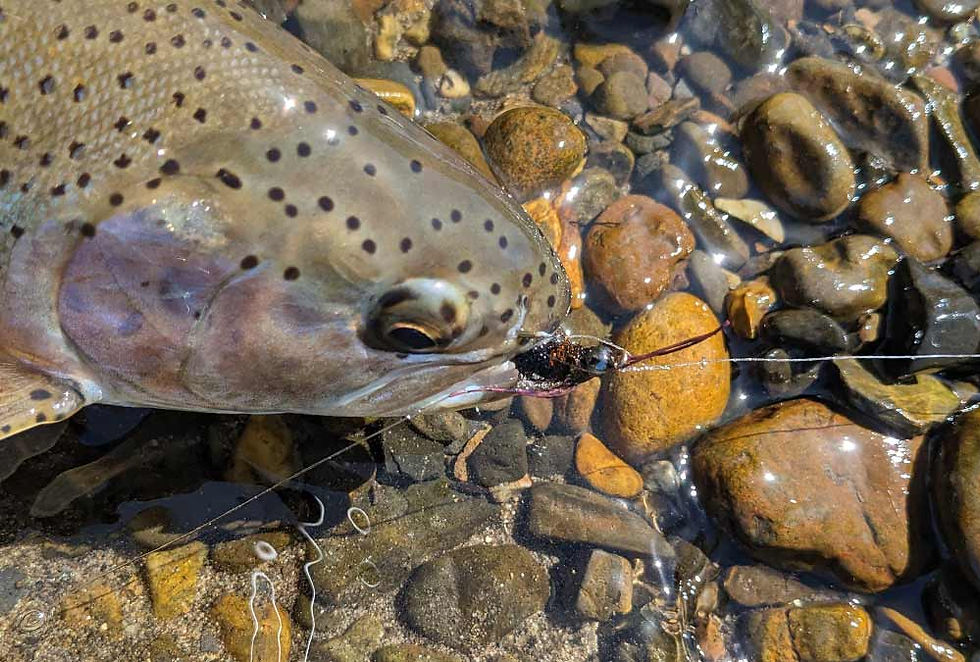The Importance of Using the Right Fly for Fishing Success
- James Art Ville
- Jun 15
- 3 min read
Updated: Jul 15

Fly fishing is often romanticized as a peaceful, almost meditative pursuit. Yet beneath the surface of flowing rivers and quiet casts lies a science as precise and essential as the flick of a surgeon’s wrist. One of the most crucial components to success in fly fishing—and often the difference between a full net and an empty day—is using the right fly.
Whether you're casting into a crystal-clear mountain stream or wading through a cloudy backwater, the fly you choose can dramatically affect your results. The right fly not only mimics local forage but also triggers instinctive strikes from trout, bass, and other game fish. Here's why getting the right fly matters—and how it can elevate your fishing game from frustrating to phenomenal.
1. Understanding the Fish’s Diet
At the core of fly fishing is the concept of "matching the hatch." Fish, especially trout, feed selectively based on what’s seasonally or locally available. This means that the insects and aquatic life present in the water at that particular time play a major role in a fish’s behavior. A dry fly that worked wonders in spring might be ignored in summer simply because the hatching patterns have changed.
By paying close attention to what insects are active—whether it's midges, mayflies, caddisflies, or terrestrials like ants and beetles—you increase your chances of choosing a fly that mimics their appearance and movement. Even small discrepancies in size, color, or presentation can be a turn-off to picky fish. When you use the right fly, you're not just casting—you're imitating dinner.
2. Depth and Water Conditions Matter
Different flies are designed for different parts of the water column. Dry flies sit on the surface, wet flies and nymphs drift below, and streamers imitate baitfish or leeches swimming through deeper water.
In clear, shallow water, subtlety is key. A realistic nymph or emerger pattern can gently coax bites. In deeper or stained water, however, a brightly colored or larger streamer may be needed to attract attention. Choosing the right fly means knowing not just what the fish are eating, but where they’re feeding.
Water speed and clarity also impact fly selection. Faster water may require heavier flies to reach the feeding zone, while glassy pools call for delicate presentation and lighter flies.
3. Seasonal and Weather Influences
Just like human behavior changes with the weather, fish feeding habits shift with the seasons. In spring, for instance, insect hatches ramp up and fish feed more actively on emerging bugs. In summer, heat may drive fish deeper, requiring weighted nymphs or streamers. Autumn often brings a return to surface action, especially with terrestrial flies like grasshoppers.
Weather conditions—especially cloud cover, rain, and wind—can also change which fly is most effective. Overcast skies often encourage fish to rise, making dry flies more viable. Bright days may push fish into the shadows, where a well-placed nymph can make all the difference.

4. Triggering the Strike
Even when fish aren't actively feeding, the right fly can provoke a reaction. Streamers, for example, are often used not because the fish are hungry, but because they’ll strike at a fast-moving target out of territorial aggression.
Flies can be tied to mimic not just insects but also small minnows, crawfish, frogs, and even worms. Using a fly that imitates the local prey species in both appearance and movement can trigger instinctive attacks.
Choosing a fly that “matches the mood” of the fish—whether they’re lethargic or aggressive—requires understanding behavior, water temperature, and current speed. That fly becomes more than bait; it becomes a psychological tool.
5. Confidence Breeds Success
There’s an underrated factor in fly choice: confidence. When an angler has confidence in a fly, their cast, retrieval, and patience often improve. A confident angler will fish a fly longer, present it better, and be more in tune with subtle takes.
While fly fishing is grounded in skill and knowledge, it’s also an art. Confidence grows with experience, and using the right fly often leads to that reinforcement loop: more strikes, better fishing, stronger instincts.
Final Thoughts
Fly fishing is a dance between nature and angler, requiring observation, adaptation, and sometimes a bit of trial and error. But when you tie on the right fly—one that matches the hatch, suits the depth, and works with the conditions—you give yourself the best possible shot at success.
Investing time into understanding local entomology, practicing fly presentation, and keeping a well-rounded fly box can all pay off. Because when the right fly meets the right fish at the right time, magic happens.
In fly fishing, as in life, details matter. And often, the smallest detail—like choosing the right fly—makes all the difference.

Comments